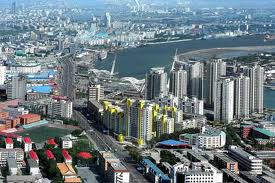Sectoral and geographical distribution of Foreign Direct Investment (FDI) in China
 As part of the economical reforms that began in 1978, the Chinese authorities shaped preferential policies to attract foreign investments. As a result, China received a hundreds of billions of dollar in FDI, making it largest developing country to host FDI as recent inflows account for nearly 40 percent of combined flows of FDI to all developing countries (IMF 2000).
As part of the economical reforms that began in 1978, the Chinese authorities shaped preferential policies to attract foreign investments. As a result, China received a hundreds of billions of dollar in FDI, making it largest developing country to host FDI as recent inflows account for nearly 40 percent of combined flows of FDI to all developing countries (IMF 2000).
Though these figures very impressive, however, there are certain problems that Chinese government has to overcome if FDI is needed to sustain country’s continuing record growth rate and further its economic development.
The figures published by OECD (2000) shows that distribution of FDI in Chine has been very disproportionate among regions. Between period of 1983 and 1998, eastern region attracted 87.8 percent of FDI whereas the central region took 8.9 percent and western region grabbed only 3.3 percent. The report states that main reason behind this inequality is inappropriate FDI policies taken by the Chinese authority. Creation of special economic zones (SEZs) and preferential regimes for 14 coastal cities resulted in geographically an overwhelming concentration of FDI in the east region. Only after adoption of more broad-based economic reforms and open door policies for FDI in the late 1990s, spreading of FDI inflows into other provinces accelerated.
However, Broadman and Sun (1997) argue that FDI’s geographically distribution in China is influenced by many different factors rather than solely government policies. They empirically analysed the geographic determinants of FDI in China and concluded that to a large extent the destination of FDI within China is determined by market size, the extent of infrastructure development, the basic education level among adults, vicinity to import and export markets as well as capital sources and special investment policies.
The sectoral of FDI varies from country to country and from year to year. As for China, its sectoral distribution is highly uneven as FDI in country is highly geographically concentrated.
Major proportion of FDI in China is directed for manufacturing field, mostly export oriented, which takes up nearly 60 percent of the total undertaken FDI by 1998. Manufacturing field is followed by real estate with the share of 24.4 percent and transport, wholesale, and retailing industries with just 6.0 percent. Next follows construction with 3.1 percent while the primary industries such as agriculture, forestry and fishing takes only 1.8 percent (OECD, 2000). Following the Chinese accession to WTO and further trade liberalizations, the service trade, such as finances, telecommunications, and wholesale and resale commerce expected to take a larger share of FDI in the future.
References
- Broadman, HG & Sun, X, 1997, “The Distribution of Foreign Direct Investment in China”, World Bank Policy Research Working Paper
- International Monetary Fund, 1997, “People’s Republic of China – Selected issues”, IMF Staff Country Reports, no. 97/72
- International Monetary Fund, 2009, “Global Shifts in Demand: Making Up for Weaker Consumption in the United States,” Box 1.8 in October 2009 Asia and Pacific Regional Economic Outlook, pp. 36–37.
- Organization of Economic Cooperation and Development, 2000, “Main Determinants and Impacts of Foreign Direct Investment in China’s Economy”, Working Papers on International Investment, No. 2000/4
